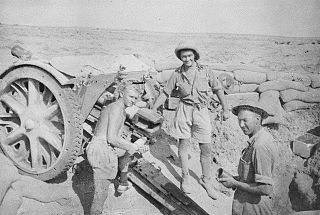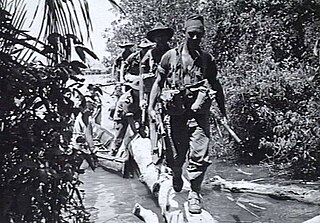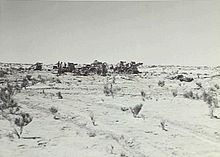
The 9th Division was a division of the Australian Army that served during World War II. It was the fourth division raised for the Second Australian Imperial Force. The distinctions of the division include it being:
The 4th Regiment, Royal Australian Artillery is an artillery unit of the Australian Army. Currently it provides close artillery support to the 3rd Brigade and is based at Chau Pha Lines, Lavarack Barracks in Townsville, Queensland. The regiment was raised in its current form in 1960 and is currently re-equipping with M777A2 lightweight towed howitzers. The regiment deployed during Australia's commitment to the Vietnam War and has subsequently deployed to Singapore and East Timor.

The 2/4th Field Regiment was an Australian Army artillery regiment formed on 2 May 1940, as part of the 7th Division during World War II. The regiment was involved in campaigns in North Africa, Syria–Lebanon, Salamaua–Lae, the Finisterre Ranges and Borneo. After training in Victoria, the regiment deployed to North Africa in late 1940. After being deployed in the defence of Mersa Matruh in Egypt in early 1941, the regiment took part in the fighting against the Vichy French in Syria and Lebanon, before undertaking garrison duties there. It returned to Australia in early 1942 following Japan's entry into the war, and in September 1943, a small group of artillerymen from the 2/4th parachuted with two short 25 Pounder guns in the airborne landing at Nadzab airstrip in New Guinea in support of the US Army's 503rd Parachute Infantry Regiment. Later, the regiment took part in the 7th Division's advance through the Finisterre Range before returning to Australia in early 1944. Its final involvement in the war came around Balikpapan in 1945. After the war, the regiment was disbanded on 7 February 1946.
The 2/7th Cavalry (Commando) Regiment was one of three commando regiments raised by the Australian Army for service during World War II. It was originally raised as the 7th Division Cavalry Regiment in 1940 and in this guise it served in North Africa and the Middle East at the beginning of the war, before it was brought back to Australia and sent to New Guinea in late 1942 to serve against the Japanese. In mid-1943 the Australian high command decided to disband the divisional cavalry regiments and use their headquarters elements to administer the independent companies that had been raised earlier in the war. In the process the 7th Division Cavalry Regiment disbanded its squadrons, gave up their vehicles and changed its name to the 2/7th Cavalry (Commando) Regiment, as it became the administrative headquarters for the 2/3rd, 2/5th and 2/6th Commando Squadrons.
The 2/9th Cavalry (Commando) Regiment was one of three commando regiments raised by the Australian Army for service during World War II. It was originally raised in 1940 as an armoured cavalry unit as part of the 8th Division, before being transferred to the 9th Division. Between 1941 and 1942 the regiment saw action in the Middle East before being returned to Australia in early 1943. At this time the regiment was re-organised as the administrative headquarters for the 2/4th, 2/11th and 2/12th Commando Squadrons and it was converted into a commando regiment. Later in 1945 the unit saw action during the landings on Tarakan on Borneo before being disbanded upon the cessation of hostilities.

The 2/5th Field Regiment was an Australian Army artillery regiment formed in May 1940 as part of the Second Australian Imperial Force for service during World War II. Assigned to the 7th Division, the regiment undertook defensive duties in Egypt during the North African campaign in early 1941, before taking part in the Syria–Lebanon campaign. Occupation duties followed before the regiment was brought back to Australia in early 1942, in response to Japan's entry into the war. The regiment subsequently fought two significant battles in New Guinea in 1942–1943 at Milne Bay and Buna before undertaking garrison duties around Port Moresby until early 1944. Withdrawn to Australia, the regiment's final campaign came late in the war when it was committed to the Borneo campaign, taking part landing at Balikpapan. The regiment was disbanded in early 1946.

The 2/12th Field Regiment was an Australian Army artillery regiment formed as part of the all volunteer Second Australian Imperial Force for overseas during World War II. Recruited in the state of Victoria in early 1940, the 2/12th was initially formed as a medium artillery regiment, but was later converted to a field regiment due to a lack of medium guns. As a field regiment, the 2/12th deployed to the Middle East where they supported the 9th Division in several battles during the North African Campaign in 1941–42, and undertook garrison duty in Lebanon. In early 1943, the regiment returned to Australia and subsequently fought in New Guinea, seeing action against the Japanese during the Huon Peninsula Campaign in 1943–44 and then the Borneo Campaign in 1945.

The 2/43rd Battalion was an infantry battalion of the Australian Army. Raised in July 1940 in South Australia as part of the 24th Brigade, the battalion was initially part of the 8th Division, until the 24th Brigade was re-allocated to the 9th Division in late 1940. It was with this formation that the 2/43rd saw service in the Middle East in 1941–1942, taking part in the fighting at Tobruk and in the First and Second Battles of El Alamein. It also undertook garrison duties in Syria, before returning to Australia early in 1943 to fight against the Japanese in the Pacific.

The 2/28th Battalion was an infantry battalion of the Australian Army, which served during the Second World War. Formed in mid-1940 from Western Australian volunteers, the battalion served in North Africa in 1941–42 as part of the 24th Brigade, which was assigned to the 9th Division. The battalion's first major engagement came during the Siege of Tobruk, where the battalion carried out defensive duties as part of the garrison for over six months before being withdrawn by sea. After undertaking occupation duties in Syria and Lebanon, the 2/28th took part in the First Battle of El Alamein in mid-1942 during which it was heavily depleted, and had to be rebuilt prior to its commitment to the Second Battle of El Alamein later in the year. In early 1943, the battalion returned to Australia and later took part in campaigns against the Japanese in New Guinea in 1943–44, where it was committed to capturing Lae, and then clearing the Huon Peninsula, and then retaking Borneo in 1945. After the war, the battalion was disbanded in early 1946.

The 2/15th Battalion was an infantry battalion of the Australian Army that served during World War II. Formed in May 1940 primarily from Queensland volunteers, the battalion saw action in North Africa in 1941–1942 as part of the 20th Brigade, which was part of the 7th Division before being reassigned to the 9th Division.

The 2/24th Battalion was an infantry battalion of the Australian Army, which served during World War II. A unit of the all-volunteer Second Australian Imperial Force, it was formed in July 1940 from primarily Victorian volunteers and was known as "Wangaratta's Own" because of the time the battalion spent in the town during its formative period prior to deployment overseas. It served in North Africa in 1941–1942 as part of the 26th Brigade, which was assigned to the 7th Division, before being reassigned to the 9th Division. In early 1943, the battalion returned to Australia and later took part in campaigns against the Japanese in New Guinea in 1943–1944 and Borneo in 1945, before being disbanded in 1946. The 2/24th suffered the highest number of battle casualties of any 2nd AIF infantry battalion.

The 2/32nd Battalion was an infantry battalion of the Australian Army, which served during the Second World War. Formed in June 1940 from surplus Australian troops who had been sent to the United Kingdom shortly after the Fall of France, the battalion was originally designated the "71st Battalion", before being redesignated. After completing training in the United Kingdom, the 2/32nd served in North Africa in 1941–1942 as part of the 25th Brigade, which was assigned to the 9th Division, before being assigned to the 24th Brigade. In early 1943, the battalion returned to Australia and later took part in campaigns against the Japanese in New Guinea in 1943–1944 around Lae and on the Huon Peninsula, and in Borneo, landing on Labuan in mid-1945, before being disbanded in 1946.

The 2/3rd Field Regiment was an Australian Army field artillery regiment that was raised for service during the Second World War. Formed in 1939 and assigned to the 6th Division, the regiment was deployed to the United Kingdom to defend against a possible invasion in 1940 before being sent to North Africa, where it briefly saw action prior to being sent to Greece and Crete in 1941. In 1942, the regiment returned to Australia, after which it did not see action again until late in the war when it was committed to the Aitape–Wewak campaign in 1944–45. Following the end of the war, the regiment returned to Australia and was disbanded in January 1946.

The 2/7th Field Regiment was an Australian Army field artillery regiment that served during the Second World War. Formed in mid-1940 and assigned to the 9th Division, the regiment was deployed to North Africa, where it saw action around Tobruk in 1941 and in the First and Second Battles of El Alamein in 1942. It also undertook garrison duties in Syria and Egypt. In 1943, the regiment returned to Australia, after which it did not see action again until late in the war when it was committed to the landing at Tarakan in 1945. Following the end of the war, the regiment returned to Australia and was disbanded in January 1946.

The 2/14th Field Regiment was an Australian Army artillery unit that served during the Second World War. Raised in late 1940 as part of the 8th Division, the regiment remained in Australia as a garrison force in Darwin when the division's infantry brigades were sent to various places around Southeast Asia to meet the threat posed by Japan. As a result, it did not deploy overseas until late 1943. In New Guinea, the regiment supported the 5th Division's operations on the Huon Peninsula throughout 1944 before deploying with them to New Britain in early 1945. From then, until the end of the war, the regiment engaged in operations against the large Japanese garrison on the island. At the end of the war, the 2/14th briefly undertook garrison duties on Rabaul as part of the 11th Division before returning to Australia and disbanding in January 1946.

The 2/11th Field Regiment was an Australian Army artillery regiment formed as part of the Second Australian Imperial Force during World War II. Formed in Victoria in mid-1940, the regiment was deployed to the Middle East in 1941 and subsequently took part in the fighting against the Vichy French in the Syria–Lebanon Campaign. In early 1942, they were brought back to Australia in response to Japan's entry into the war, and in 1943 joined the garrison in Darwin. Throughout 1944–45, the regiment was deployed to New Guinea before supporting the 3rd Division's campaign on Bougainville. After the war, the regiment was disbanded.

The 2/2nd Field Regiment was an Australian Army field artillery regiment that was raised for service during the Second World War. Assigned to the 6th Division, the regiment was formed from Second Australian Imperial Force volunteers. Raised in October 1939, the regiment undertook basic training in Australia before departing for the Middle East in mid-1940. Further training was undertaken in Egypt, before the regiment saw action in the Western Desert in early 1941, and in Greece and on Crete in the middle of the year. Later, they provided a defensive garrison on Ceylon in mid-1942 before returning to Australia. It did not see further action until the final phase of the war, when it was deployed to Aitape–Wewak, fighting against the Japanese, in 1944–1945. It was disbanded in January 1946, after returning to Australia for demobilisation.

The 2/6th Field Regiment was an Australian Army artillery regiment formed as part of the 7th Division in May 1940 for operations during World War II. The regiment served in Egypt and Syria in 1941–1942 before returning to Australia after Japan's entry in the war. Throughout 1943 and 1944, the regiment served against the Japanese in New Guinea. The regiment's involvement in the fighting in New Guinea saw it committed to several campaigns, including those around Salamaua and on the Huon Peninsula. Its final campaign of the war was fought on Borneo in mid-1945. Shortly after the conclusion of hostilities, the regiment was disbanded in late 1945.
The 2/9th Field Regiment was an Australian Army artillery regiment formed as part of the all volunteer Second Australian Imperial Force in July 1940 for operations during World War II. Assigned to the 1st Australian Corps, the regiment was sent to the Middle East in mid-1941, and served in Palestine, Egypt, and Syria before returning to Australia in 1942. It undertook defensive duties in south-east Queensland before deploying north to Merauke, in Dutch New Guinea, and Cape York. It returned to Australia in October 1944 and sent to the Atherton Tablelands to carry out training as it waited for further deployment. This never came and the regiment was disbanded in late 1945.

The 2/3rd Anti-Tank Regiment was an Australian Army anti-tank artillery regiment that was raised for service during the Second World War as part of the all volunteer Second Australian Imperial Force. It was formed in July 1940, and was assigned to the 8th Division, but was later reassigned to the 9th Division. With this formation, the regiment took part in the Siege of Tobruk in 1941 and then the First and Second Battles of El Alamein in 1942. After returning to Australia in early 1943, the regiment became a corps-assigned unit, and its individual batteries served in New Guinea in 1943–1944, and then Borneo against the Japanese in 1945.

















